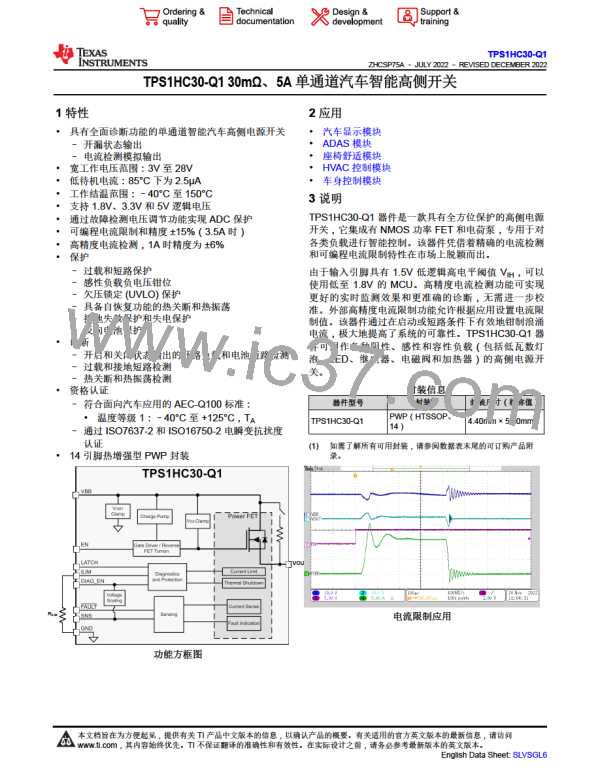TPS1HC30-Q1
ZHCSP75A –JULY 2022 –REVISED DECEMBER 2022
www.ti.com.cn
Max Load Current for
Application
RILIM
KCL
Minimum Current Limit
(at VDS = 3 V)
Short Circuit Regulation
value at VBB = VDS = 18 V
1.5 A
3 A
1.53 A (1.94 A -21%)
3.06 A (3.6 A - 15%)
6.03 A (7.8 A - 23%)
2.5 A, +11%
4.6A, +13%
10.6 A, +11%
47.5 kΩ
25 kΩ
92.4 A × kΩ
90 A × kΩ
88.2A × kΩ
6A
11.3 kΩ
8.3.2.1 Capacitive Charging
The following figure shows the typical setup for a capacitive load application and the internal blocks that function
when the device is used. Note that all capacitive loads have an associated "load" in parallel with the capacitor
that is described as a resistive load but in reality it can be inductive or resistive.
VBAT
VBB
Smart High Side Switch
EN
Gate Driver
KCL
ILIM1
=
RILIM
ILIM
Current Limiting
Circuit
(VBB – VOUT
RLOAD
)
INOM
=
VOUT
RILIM
CLOAD
GND
RLOAD
ILIM = CLOAD x dVDS/dt
图8-8. Capacitive Charging Circuit
The first thing to check is that the nominal DC current, INOM, is acceptable for the TPS1HC30-Q1 device. This
check can easily be done by taking the RθJA from the Thermal Information section and multiplying the RON of
the TPS1HC30-Q1 and the INOM with it, add the ambient temperature and if that value is below the thermal
shutdown value the device can operate with that load current. For an example of this calculation see the
Applications section.
The second key care about for this application is to make sure that the capacitive load can be charged up
completely without the device hitting thermal shutdown. The reason is because if the device hits thermal
shutdown during the charging, the resistive nature of the load in parallel with the capacitor starts to discharge the
capacitor over the duration the TPS1HC30-Q1 is off. Note that there are some application with high enough load
impedance that the TPS1HC30-Q1 hitting thermal shutdown and trying again is acceptable; however, for the
majority of applications, the system must be designed so that the TPS1HC30-Q1 does not hit thermal shutdown
while charging the capacitor.
With the current clamping feature of the TPS1HC30-Q1, capacitors can be charged up at a lower inrush current
than other high current limit switches. This lower inrush current means that the capacitor takes a little longer to
charge all the way up. The time that it takes to charge up follows the equation below.
ILIM = C × d(VBB –VDS) / dt
(3)
However, because the VDS for a typical 3.3-A application is much less than the VBB voltage (VDS ≅ 3.3A × 0.03
Ω= 100 mV, VBB ≅ 13.5 V), the equation can be rewritten and approximated as
dt = C × dVBB / ILIM
(4)
The following figure pictures charge timing.
Copyright © 2023 Texas Instruments Incorporated
Submit Document Feedback
23
Product Folder Links: TPS1HC30-Q1

 TI [ TEXAS INSTRUMENTS ]
TI [ TEXAS INSTRUMENTS ]